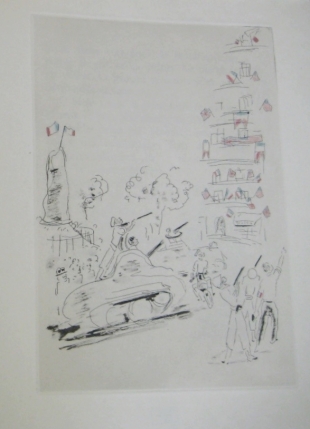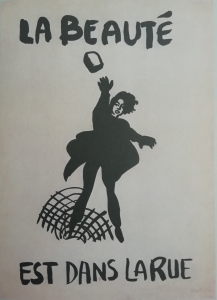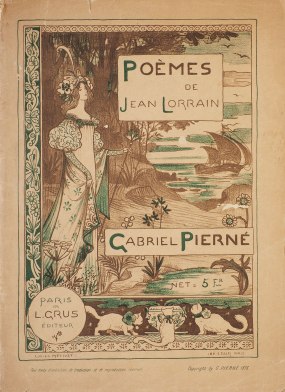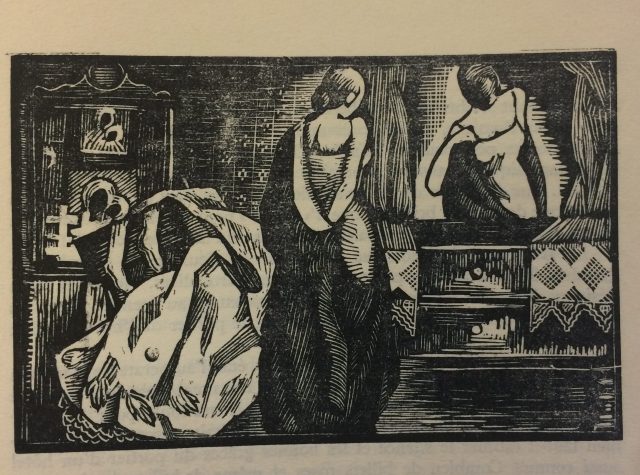The police killing of 17-year-old Nahel Merzouk on 27 June in Nanterre (in the suburbs of Paris) and civil unrest that occurred subsequently in France show how challenging it is to uphold the values of equality and fraternity, both socially and institutionally. For Bastille Day this 14th of July, we focus on the famous poem ‘Liberté’, initially entitled ‘Une seule pensée’, composed by Charles Eluard under the German occupation of France in 1941. This love poem to Nusch was turned into a celebration of and aspiration to Freedom. It is marked by the leitmotiv “J’écris ton nom”, reminding us of the power of both speech and writing. While the collaborationist Vichy régime had replaced the French revolutionary motto from “Liberté, Egalité, Fraternité” to the conservative “Travail, Famille, Patrie”, the poem “Liberté” became emblematic of French resilience throughout the Second World War and beyond. This blogpost gives an overview of the early publications of the poem: many of which are available at Cambridge University Library, including special editions with the Eluard’s signature and dedications, within the Chadwyck-Healey Liberation collection.
Tag: book illustrations
The Fritz Möser collection: outstanding 20th century linoprints

Finishing touches are being put to the processing of the Fritz Möser donation, a long-term project that we have returned to when our department’s capacity has allowed. This is a collection of the graphic work of artist Fritz Möser (1932-2013) and was donated by Hans-Jörg Modlmayr and his wife Hildegard Modlmayr-Heimath who both taught in the German Department of Cambridge University between 1969 and 1973. The collection comprises more than 40 sets of large-scale linoprints, all in limited editions, more than 200 private press books, more than 30 issues of the literary magazine Wegwarten and 15 examples of annual calendars. This blog post will showcase a selection of Möser’s striking and beautiful artwork.
Covers of the annual calendars in our collection (CCA.61.8-22) Continue reading “The Fritz Möser collection: outstanding 20th century linoprints”
The Liberation of Paris, 19-29 August 1944: “Images de notre délivrance” by Georges Duhamel and Claude Lepape
 On the 75th anniversary of the Liberation of Paris, we would like to talk about Images de notre délivrance (Liberation.a.7), published in December 1944 by the Editions du Pavois (the publisher in 1946 of L’Univers concentrationnaire by David Rousset, which was awarded the Renaudot prize, Liberation.c.119 and Liberation.c.918). The book, clearly of a bibliophile nature, is presented by the editor as a documentary, the result of an accidental collaboration between a writer, Georges Duhamel (1884-1966), and an artist, Claude Lepape (1913-1994), both reacting to a unique historical event:
On the 75th anniversary of the Liberation of Paris, we would like to talk about Images de notre délivrance (Liberation.a.7), published in December 1944 by the Editions du Pavois (the publisher in 1946 of L’Univers concentrationnaire by David Rousset, which was awarded the Renaudot prize, Liberation.c.119 and Liberation.c.918). The book, clearly of a bibliophile nature, is presented by the editor as a documentary, the result of an accidental collaboration between a writer, Georges Duhamel (1884-1966), and an artist, Claude Lepape (1913-1994), both reacting to a unique historical event:
Ce livre est un document. Il est né de la rencontre fortuite de deux sensibilités. L’Ecrivain et le Dessinateur ne se sont pas concertés, mais leurs réactions, si diverses et en même temps si proches, constituent l’un des documents les plus émouvants sur les glorieuses journées de la libération.
“Soyez réalistes, demandez l’impossible” May 1968 France

“Be realistic, ask the impossible” was one of the many slogans of the French unrest in May-June 1968. May last year was the 50th anniversary of the upheaval, which arouses mixed feelings in French society, depending on the political ideas of each individual. There was a debate in 2017 about Emmanuel Macron’s idea of celebrating May 68, when it had been an anti-governmental, non-institutionalised movement; it certainly led to many cultural events in 2018, including the BnF exhibition: The spirit(s) of May 68. Cambridge University Library purchased many of the publications on May 68 which came out around the time of the anniversary, including 1968 : de grands soirs en petits matins (C214.c.7787) and L’esprit de mai 68 (C205.d.9998). Here we highlight some of the books we have received in the past year or so. Continue reading ““Soyez réalistes, demandez l’impossible” May 1968 France”
The Martin Stone collection of French illustrated poetry, 19th-20th centuries at Cambridge
Cambridge University Library has just acquired a collection of about 230 French illustrated poetry books ranging from 1841 to 1970 and beyond. They were collected by Martin Stone, an English guitarist as well as rare books dealer and collector who passed away in 2016. The collection consists mainly of outstanding first editions, many of which printed on special paper and containing signatures and dedications by and to prominent figures of the Parisian art world (Cocteau, Apollinaire, Marie Laurencin etc.). It is very strong from a literary perspective, with major or lesser-known French and Belgian poets, ranging from Symbolist and Decadent writing to the 20th century Modernist avant-gardes, which reverberated across the globe.

Twentieth century German woodcuts

I recently catalogued a book from 1927, Der Niederrhein im Schrifttum alter und neuer Zeit (S950.b.9.1244), an anthology of writing about the Lower Rhine region of Northern Germany, illustrated with the most striking woodcuts. Some of these date from pre-1500 as the example to the right (or above if viewed on mobile phone) illustrates, but the majority are contemporary Expressionist works created by either Artur Buschmann or Anton Wendling, both artists I had not heard of before. The woodcut as a medium was particularly used by Expressionist artists in Germany.
Buschmann (1895-1971) was a local artist, best known for his paintings. He also worked as a draughtsman throughout his career. He had served in World War One but spent some time recuperating from a gas attack. By the 1920s he was part of the art scene in Düsseldorf. Here is a small selection of his woodcuts from the book (click on each image to see enlarged version): Continue reading “Twentieth century German woodcuts”
Alice in translation
In October 1866 Lewis Carroll told his publisher Macmillan that his friends in Oxford “seem to think that the book [Alice’s adventures in Wonderland] is untranslatable”. History has proved his friends very wrong, as a new three volume acquisition by the Library, Alice in a world of wonderlands : translations of Lewis Carroll’s masterpiece, edited by Jon A. Lindseth (S950.b.201.3527-3529), makes clear.
– Waddleton.c.1.395
A Croatian picture dictionary : the February 2017 Slavonic item of the month
We have recently started to catalogue various reference works transferred to the University Library from the Modern and Medieval Faculty Library’s Balkan section. Most are academic dictionaries, but among them is the delightful 1938 Croatian picture dictionary Sta je sta (What is what). Each opening provides often quite complex terminology facing illustrative pictures. Produced by two academics and writers, Iso Velikanovic and Nikola Andric, the 685-page dictionary covers a huge number of topics in quite extraordinary detail. Even cricket is included.

Continue reading “A Croatian picture dictionary : the February 2017 Slavonic item of the month”
Illustrations for Soviet children (and postcards for Christmas!) : the December 2016 Slavonic item of the month
‘Kniga dlia detei 1881-1939’ (Books for children, 1881-1939; S950.a.200.4173-4174) is a huge two-volume set which contains reproductions of excerpts from beautifully illustrated Russian children’s books. It was produced in 2009 but is a only a recent arrival in the University Library.
The two volumes (right) and a winter scene (left).
The set is based on the collection of a New York Russian emigre. Aleksandr Lur’e (or Sasha Lurye) has collected hundreds upon hundreds of late imperial and early Soviet children’s books, a great many of which researchers would struggle to track down in libraries today. The two volumes follow a roughly chronological order in terms of the books their sections study. Continue reading “Illustrations for Soviet children (and postcards for Christmas!) : the December 2016 Slavonic item of the month”
When the illustrations are more interesting than the novel: Le Livre de Demain
We write quite frequently on this blog about donations to the University Library, not because this material necessarily makes up a large proportion of what we acquire, but more probably because we (the people writing these posts) find old books to be interesting. That is the case with a dozen volumes that we accepted as a donation in the series Le livre de demain, published by Arthème Fayard. I’m sure the novels in these books are worthwhile and interesting, but we accepted them primarily because of their illustrations. For the purposes of the UL, while the novels themselves are unlikely to be heavily used, the illustrations are much more interesting.
All books in this series have woodcuts created specifically for the publications. They are in general by illustrators who are represented elsewhere in the UL. The novels sometimes appear elsewhere in the UL, sometimes not.
A couple of examples of these novels and their illustrations follow:
Ariane, jeune fille russe
Written by Claude Anet, the pseudonym of Jean Schopfer (a writer and tennis player), this novel was adapted several times for cinema– most notably for a 1957 film by Billy Wilder. Cambridge libraries have numerous copies of the novel (and English translations). This edition, which stands at 2016.9.4412, has 29 woodcuts by Angelina Beloff.

La fée de Port-Cros, ou, La voie sans retour
Written by Henry Bordeaux, our copy (2016.9.4413) in this series is illustrated by Jean Constant Raymond Renefer, who illustrated one other book from the collection in the UL. He was primarily a painter, most well-known for his paintings of soldiers during the First World War.

Josh Hutchinson











